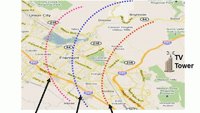Could new ‘SuperTV’ reception technology change the Mobile DTV equation?

While television broadcasters in the United States continue to slog through the engineering, marketing and receiver device issues to make Mobile DTV a success, a new receiver technology for reception of conventional 8-VSB ATSC transmission promises to take pristine DTV reception off the rooftop and put it on the road.
Legend Silicon, a fabless semiconductor company specializing in TV receiver demodulators in Fremont, Calif., is targeting the 2012 International Consumer Electronics Show in Las Vegas next month for a demonstration of a new automobile-based TV reception system for legacy ATSC A/53 signals.
The demonstration will rely on a technology the company has dubbed SuperTV, a maximal-ratio combining (MRC) diversity reception technology for single-carrier terrestrial television broadcasts. According to Legend Silicon COO and VP of product marketing Raj Karamchedu, the CES showing will use an FPGA-based version of SuperTV technology using four car antennas that makes possible reception of legacy ATSC from a moving vehicle.
Although ATSC A/53 was designed for reception of 8-VSB by a TV antenna mounted some 30 feet overhead on a rooftop, SuperTV combines signals from multiple antennas to achieve ground-level reception capable of defeating both Doppler effects and multipath problems that normally would prevent reception of conventional DTV signals in a moving car, said Karamchedu. With two antennas and the MRC technology, the company has seen antenna gain as high as 7dB, and with four it has achieved 12dB of antenna gain, he added.
“With our breakthrough SuperTV technology, for the first time our customers can enhance picture reception quality by simply adding more antennas,” said Dr. Lin Yang, Legend Silicon co-founder, CTO and inventor of single-carrier MRC diversity technology in a company press release.
The MRC technology behind SuperTV initially was developed for high-performance car DTV reception of single-carrier OTA broadcasts of the China DTMB standard, and is being deployed by Hirschmann Car Communications in premium cars destined for China. It is already in mass production in the company’s dual-mode terrestrial-cable DTV demodulator for national CTTB standard broadcasts in China.
Beyond automobiles, the company envisions SuperTV technology being deployed in the United States for stationary and portable DTVs, laptop computers, tablet devices and mobile phones, said Karamchedu. The same technology also can improve the performance of Mobile DTV (A/153) receivers, he added.
The professional video industry's #1 source for news, trends and product and tech information. Sign up below.
Legend Silicon hopes to begin production of an IC SuperTV chip within six to seven months and sees consumer electronics companies bringing the technology to market for TV viewers in time for the 2012 Christmas holiday shopping season.
Word of SuperTV likely will be met by some in the broadcast engineering community with a degree of skepticism. “The mobile environment, in the presence of lots of signal multipath, is inherently very hostile to legacy ATSC reception,” said Charles Cooper, a broadcast engineer with the engineering consulting firm du Treil, Lundin & Rackley. “So any new antenna technology will have to overcome very high technical hurdles to make legacy ATSC a reliable mobile service.”
“A minimum signal-to-noise ratio of 15.2dB is still required for legacy reception — regardless of the receive antenna configuration,” he added.
Phil Kurz is a contributing editor to TV Tech. He has written about TV and video technology for more than 30 years and served as editor of three leading industry magazines. He earned a Bachelor of Journalism and a Master’s Degree in Journalism from the University of Missouri-Columbia School of Journalism.

